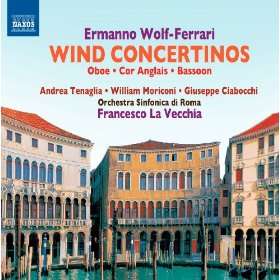|
Back
08/16/2012
Ermanno Wolf-Ferrari: ”Idillo” concertino in A major for Oboe and small orchestra, opus 15 – Concertino in A-Flat major for Cor anglais and small orchestra, opus 34 – Suite-concertino in F major for Bassoon and small orchestra, opus 16
Andrea Tenaglia (Oboe), William Moriconi (Cor anglais), Giuseppe Ciabocchi (Bassoon), Orchestra Sinfonica di Roma, Francesco La Vecchia (Conductor)
Recording: ORS Studios, Rome (June 24-27, 2009) – 77’ 32
Naxos #8.572921 – Booklet in English and Italian

   
Growing up with a mother of Italian birth and an artistic father of Bavarian origin makes for an Ermanno Wolf-Ferrari filled with torment with regard to nationalistic loyalties. Although there are strident grumblings of patriotic favoritism, the Italian-Germanic composer extrapolated nicely within the confines of 20th century music. His end result portfolio is anchored in beauty, demonstrating a decorum of respect for his predecessors’ formulated interpretations and resolve. What one will find is an extraordinary sampling that highlights three soothing woodwinds with gradient levels of octave range: firstly, the oboe; secondly, the Cor anglais; thirdly, the bassoon. It’s a grand educational exposé for musically-minded students, but it is also a great revisit for those heavily educated in the background of early 20th century classical music with underpinnings of the Baroque and Classical styles. This sampling is superior.
These inclusive woodwinds first showcase Wolf-Ferrari’s display in the bucolic setting of the “Preambolo” found in his Idillio-concertino in A major where strings have a witty musical tête-à-tête with Andrea Tenaglia’s lucid expression on the oboe. The “Scherzo” is more uninhibited which is followed by the longest section, “Adagio”, that has immediate reflections of Antonín Dvorak’s New World Symphony. This, however, soon unravels into a lugubrious melody permitting Tenaglia to make full use of the oboe’s ability to elicit levels of marvelous coloring. Due to its length allows one to strengthen on the focus of Wolf-Ferrari’s inner feelings and his profound love of music. The movement forwards with increasing tension, yet it finds a peaceful solace in the ending bars to a major resolve. The euphonious élan in the final “Rondò” gives an edge of seriously frivolous compensation. This Concertino has a way of breaking molds of earlier preconceived notions, yet it is grounded in musical theory and principles which everyone will enjoy.
We experience the next woodwind with a drop in range in comparison to the oboe in the “Prelude”: an almost gavotte-like stance with dignified sophistication permeates with subdued exuberance. William Moriconi’s tonal display on the Cor anglais evinces a deepened, yet softened approach to Ermanno Wolf-Ferrari’s 1947 composition. It is sincere, light, and approachable. “Capriccio” aptly describes the Concertino’s second movement with a flitter of unexpected delight. Similarly, this second Cor anglais-driven “Adagio” has a heftier profundity alongside laborious extrapolations. The conclusive “Finale” gives way to a more optimistic response from earlier movements, and Moriconi has connective insights into using the Cor anglais to mark Wolf-Ferrari’s score with a ray of brilliance.
Listening to the bassoon can be compared to that of a mature adult. There is a dignified grounding and seasoned flair with reflections of tonal cohesiveness that’s well captured with kindness and respect by Giuseppe Ciabocchi. “Drawn out with somber beauty” can categorize Wolf-Ferrari’s final Suite-concertino in the opening “Nocturne.” The encouraging pacing and extended values makes the labeling, “Andante un poco mosso”, in appropriate fashion; the shimmering and unexpected auras abound.
Pursuant to the first section is the abbreviated ¾ time “Strimpellata”, ringing with dance-like rhythms, yet pausing for clauses or orchestral flavor that’s indicative of operatic magic. The second movement is the most satisfying display of perk and punch. We reflect back to pensiveness in the subsequent “Canzone” that has Ciabocchi in full command of unparalleled musical fluency. The “Finale” ends the Suite-concertino with fulfilling happiness and optimism with gradient dignity.
20th century music can conjure cacophonous harmonics through dissonant values, yet this is the beauty found within Ermanno Wolf-Ferrari, for he has a respectful foundation of classical traditions, veiled in modernistic values. This superbly catalogued selection of Wolf-Ferrari’s woodwind/orchestral compositions is top notch.
Christie Grimstad
|